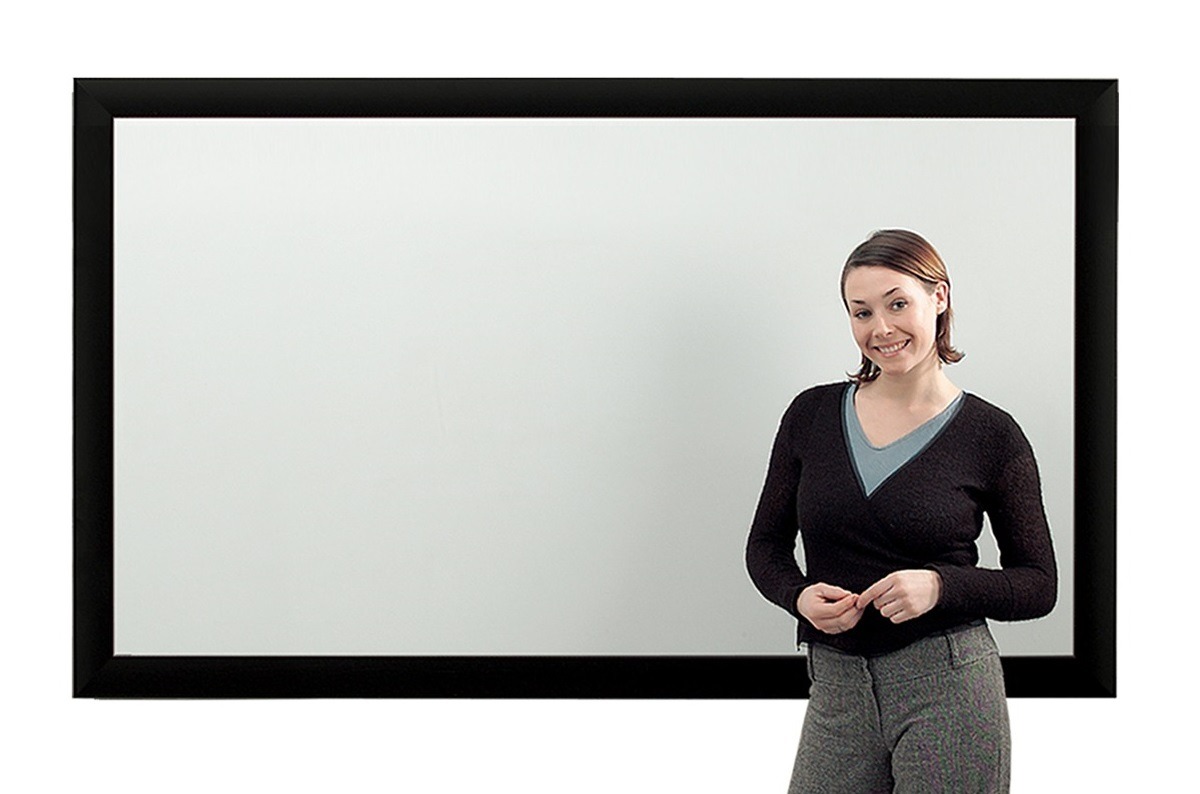Projector screens are the best display systems for educators and businesses because they cost considerably less than LCD and LED screens while providing a brighter image thanks to the reflective nature of the surface material.
The fact that projector screens are available in portable guise with easy-to-assemble tripods and stands also means you can move presentations around.
Hook up an interactive projector such as the Epson EB1485FI to your projector screen, and you can even interact with content in real time.
However, the most significant benefit of projector screens is they can be much larger than standard displays. While a TV series might reach 85″, a projector screen can be 5m wide or more, providing a perfect viewing experience in large, open spaces.
Businesses and educators choose projector screens when they need something large, easy to transport, and easy to hide when not in use.
The addition of electric mechanisms makes them a dream to use, and you can also bundle a projector with the screen to assure compatibility.
Screen projector
A screen projector is essential for schools, colleges, and businesses looking to enhance their presentations and create a more engaging learning or working environment.
With the development of technology, projectors are now a common sight in lecture halls, boardrooms, and other gathering places.
However, the kind of screen being utilised significantly impacts the projected image’s quality. Selecting the appropriate screen size and technology for optimal viewing experiences is essential.
Factors to consider include screen size, aspect ratio, and gain based on the size of the room and the distance between the audience and the screen.
With widescreen presentations, a 16:9 aspect ratio is perfect for videos, movies, and anything that requires a wider view. A 4:3 aspect ratio is better for traditional presentations, like PowerPoint slides and photos.
Our Manual Economy Projector Pull Down Screen is a fantastic low-cost 4:3 screen, or we have an Economy Electric Screen in 16:4.
Gain is also important. The gain of the screen refers to its ability to reflect light. In environments with high ambient light, such as classrooms with huge windows or well-lit meeting rooms, a higher gain means more light is reflected, producing a brighter image.
On the other hand, a lower gain screen is more suitable for spaces with controlled lighting, as it reduces the risk of hotspots or uneven brightness.
Matte white screens are the most common and provide sound colour reproduction and wide viewing angles. Glass bead screens enhance the brightness and sparkle of the image, making them ideal for environments with low ambient light.
Portable projector screen
A portable projector screen is ideal for institutions and businesses requiring flexibility and portability. Whether you need to move the screen between classrooms, meeting rooms, or off-site locations, a portable projector screen allows easy setup and transportation without compromising image quality.
Portable projector screens come in various sizes and formats, offering flexibility to adapt to different spaces and requirements.
The most popular portable screens include tripod projector screens and pull-up floor screens, which are easy to roll up and carry around.
Your portable screen should be light and simple to set up without much equipment. Some portable screens even come with a carry case, making it convenient to transport and protect the screen when not in use.
When choosing a portable projector screen, consider factors such as stability, ease of setup, and screen material. Stability is crucial to ensure the screen remains steady during presentations or meetings. Look for screens with sturdy frames, adjustable legs, or additional stabilisation features like weighted bases or tensioning systems.
Ease of setup is another crucial aspect, especially when time is limited. Look for screens with simple assembly or mechanisms like pop-up or pull-up designs. This will enable a quick and easy setup while saving time and effort.
The screen material is also a crucial consideration for portable projector screens. As with non-portable screens, consider the screen gain, and aspect ratio.
Screen and projector bundle
A screen and projector bundle offers excellent value and convenience for schools, colleges, and businesses seeking a comprehensive, cost-effective solution.
You can expect to save 10-20% with a projector and screen bundle, although leading brands like Epson teeter towards the lower end.
Investing in a bundle ensures compatibility between the screen and projector, guaranteeing optimal image quality and ease of use. If you are concerned about your screen and projector working well together, then a bundle is your best option.
A screen and projector bundle typically includes a screen, a projector, and additional accessories like cables, mounts, or remotes. Purchasing these items together will save you time and effort researching and selecting individual components.
The best projector brands include Epson, Vivitek, Sony, Viewsonic, and Panasonic, while the likes of DA-Lite make projector screens. Our screens are sourced from reputable brands to ensure the highest quality.
When considering a screen and projector bundle, assessing your institution or organisation’s specific needs and requirements is essential.
Consider the following points:
- Room size.
- Audience position.
- Throw (the distance between the projector and screen).
- Screen portability (e.g., tripod, carry case).
- Connectivity (e.g., wireless share, HDMI).
- Use case (e.g., presentations, videos).
- Brightness (a higher maximum brightness is better outdoors).
Remember to consider your primary use case and environment when buying a projector and screen bundle. Choosing a trustworthy brand will also ensure you get an efficient, cost-effective solution that lasts years.



